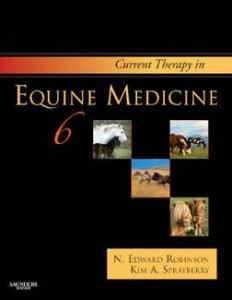 This text continues on in the format of the previous five editions. It is a multi-author book comprising chapters on clinical pharmacology, medico-legal, nutrition, behaviour, infectious disease, the cardiovascular system, the gastrointestinal system, the musculoskeletal system, the nervous system, the eye, integument, endocrine and urogenital systems, reproduction, the foal and a miscellaneous chapter covering the geriatric horse, chronic weight loss, stem cell therapy, laser equipment, hyperbaric oxygen therapy and maintenance of horses in a sling among others. There is also a table of common drugs and the approximate doses as well as normal clinical pathology data.
This text continues on in the format of the previous five editions. It is a multi-author book comprising chapters on clinical pharmacology, medico-legal, nutrition, behaviour, infectious disease, the cardiovascular system, the gastrointestinal system, the musculoskeletal system, the nervous system, the eye, integument, endocrine and urogenital systems, reproduction, the foal and a miscellaneous chapter covering the geriatric horse, chronic weight loss, stem cell therapy, laser equipment, hyperbaric oxygen therapy and maintenance of horses in a sling among others. There is also a table of common drugs and the approximate doses as well as normal clinical pathology data.
The text is well illustrated with a small number of black and white photographs, diagrams and images and 31 colour plates in nearly 1000 pages of print. Each chapter is written by an expert in that field, the information provided if of a high standard and generally comprehensive. There are no references cited in the text however there is a short list of suggested further reading provided in each chapter as well as some websites to explore.
Earlier versions of the text tended to cover selected topics within each body system which required the reader to have multiple editions in order to have all aspects of equine medicine covered. This sixth edition however seems to cover most aspects of equine medicine as well as many areas of basic surgery and diagnostic imaging, although the editors advise for complete coverage the fourth and fifth editions should be consulted.
There are some sections that are not normally covered in equine texts. For example “Assessing Saddle fit in Performance Horses”, “Biochemical tests for cardiovascular injury”, “Anaesthetic at high altitude” and “The silicosis and osteoporosis syndrome” which make for interesting night time reading. There is also good coverage of many newer areas, particularly those involving nuclear magnetic resonance imaging.
There is an interesting chapter on medico-legal which covers Reading and Interpreting Scientific Literature, Equine Insurance, Protecting Yourself with Medical Records, The Unwanted Horse and Field Necroscopy. The section on Equine Insurance is very general and covered in only one-and-a-half pages. Given this area probably creates more problems for equine practitioners than many others and whole texts are devoted to this subject more discussion might have been useful. By way of comparison more information is given about Yucca in the section on herbs and natraceuticals than is devoted to the role of the vet dealing with insured horses. There a few other chapters where readers with good knowledge of a particular subject might find the information provided to be too general however given the vast range of topics covered it is not possible to go into great depths in every chapter.
The index can also be a little confusing due to the inclusion of a full index to the previous (fifth edition) at the end of the book, directly after the index to this edition. There is no obvious demarcation to the two so the reader needs to be careful to consult the correct index.
This is a very comprehensive text covering a diverse range of topics and should be of interest for anyone involved in equine practice. Veterinarians who feel they may have not kept pace with developments in equine veterinary science over the last five to 10 years or so should peruse this book from cover to cover. It also serves as an excellent reference text and I am sure would be repeatedly consulted in any equine practice.
Given the excellent quality of the text this sixth edition should be an essential edition to the library of any equine veterinary clinic.
NICHOLAS KANNEGIETER
Specialist Equine Surgeon
BVSc, DipVetClinStud, PhD, FACVSc

